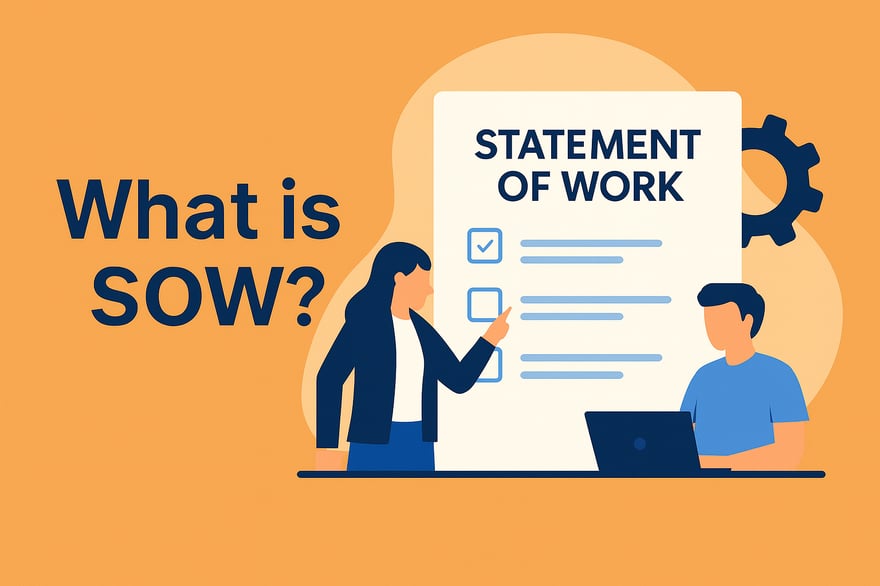
A statement of work (SOW) is a document that defines the what, when, how, and how much of a business relationship.
It’s the part of the contract where expectations get specific: the scope, the deliverables, the deadlines. And if it’s vague, incomplete, or wrong? The whole project suffers.
Why SOWs Matter
You can have a beautifully written contract…and still end up in a mess if the SOW is unclear. That’s where the real stakes live: what’s actually getting done, who’s doing it, and how the parties will measure success.
Miss something here, and you invite scope creep, payment disputes, missed deadlines, and strained relationships.
Imagine this:
You hire a vendor to “build a web portal.” That’s it. No timeline. No deliverables. No definition of “done.” Three months in, they say they’re finished. You disagree. They stop responding. You’re stuck.
A good SOW prevents that. It defines the deal.
Here are seven key things to consider when creating SOWs.
1. What Is an SOW, Exactly?
An SOW is a detailed document that lays out the specific tasks, timelines, deliverables, and payment terms for a project or service engagement. It often functions as an attachment or exhibit to the main contract, but it’s where most of the work gets defined.
A typical SOW includes:
- Scope of services — what work is being done, and what’s not included
- Deliverables — the actual outputs being produced
- Timelines — when things need to happen or be completed
- Responsibilities — who’s doing what (customer / client, vendor, third parties)
- Payment terms — how much will be paid, by whom, when, and for what
- Approval criteria — how completion and acceptance will be determined
In short, the SOW is what turns a contract from theory into action. It’s where intentions become instructions.
2. How Is an SOW Different From a Contract?
SOWs are often confused with other legal documents, especially master service agreements (MSAs) or other types of contracts. They’re closely connected — but they serve different purposes.
SOW vs. Contract (In General)
In many cases, the SOW is part of the contract. It's usually attached as an exhibit or schedule. The contract creates the legal obligation between the parties, while the SOW spells out the operational details of that obligation.
If a dispute arises, the contract governs the legal framework — but the SOW often determines whether the work was done as promised.
SOW vs. MSA
Think of the MSA as the rulebook, and the SOW as the game plan. The MSA sets the overall relationship: legal terms, intellectual property rights, dispute resolution, and more. The SOW defines a specific project: what’s getting done, by what deadlines, and for how much compensation.
You might sign one MSA, and attach ten different SOWs to it over time.
SOW vs. NDA
A non-disclosure agreement (NDA) protects confidentiality. It’s about what you don’t say.
An SOW is the opposite, in a sense — it’s where you say everything. In detail. With deadlines.
3. When Do You Use an SOW?
Any time a project or service involves custom work, multiple steps, or shared expectations, an SOW can protect both sides. SOWs are especially useful when a project includes milestones or phases, multiple stakeholders, or time-bound tasks, or just needs a clear paper trail for performance and accountability.
Common examples include:
- Consulting engagements — defining scope, timelines, and what counts as “complete”
- Software development or design projects — listing features, versions, and delivery deadlines
- Marketing agency work — specifying campaign goals, channels, creative assets, and review stages
- Custom manufacturing — outlining production specs, volume, quality assurance steps, and delivery terms
- Government contracts — where clear deliverables and compliance standards are required
- Procurement processes — where internal buyers and external vendors need to align in detail
Your contract spells out legal terms, but the SOW is where the actual work gets real. It’s not just a formality; it’s your project roadmap.
4. Who Writes and Reviews an SOW?
Creating an SOW is usually a collaborative effort, and the participants often vary depending on the industry, organization size, and deal complexity.
Drafting
Drafting often starts with operations teams (especially for client-facing or delivery-heavy work), sales or business development (when scoping is part of the proposal), or project managers (for more technical or structured engagements). They’re the ones closest to the day-to-day details of what’s being promised, and what’s feasible.
Review & Approval
Once drafted, an SOW typically goes through:
- Legal review — to ensure consistency with the governing contract or MSA
- Finance or leadership sign-off — especially for high-value or high-risk engagements
- Vendor-client negotiation — both sides may tweak timelines, scope, or deliverables before finalizing
Legal teams often serve as the final checkpoint, catching vague language, conflicting definitions, or approval criteria that could create disputes down the line.
It’s not just paperwork. A well-reviewed SOW can prevent delays, reduce risk, and keep everyone aligned when the project hits real-world bumps.
5. Common Mistakes (and How to Avoid Them)
Even a solid contract can’t save you if the SOW is vague or flawed. Here are some of the most common SOW mistakes, and how to stay clear of them:
Vague Deliverables
Phrases like “support as needed” or “launch a marketing campaign” leave too much room for interpretation. Define exactly what will be delivered, in what format, and how the parties will measure performance.
How to avoid it: Use specific, tangible language. If something will be “completed,” say what “complete” means.
Unrealistic Timelines
Overpromising (or underestimating) deadlines is a setup for failure. And “TBD” isn’t a timeline.
How to avoid it: Set deadlines that are realistic for both sides — and account for revisions, reviews, and dependencies.
Scope Creep
When the SOW is too loose, clients or internal teams may assume they can add tasks without new approvals. That leads to overwork, underdelivery, or both.
How to avoid it: Define what’s out of scope as clearly as what’s in scope, and make change control part of the process.
Misaligned Expectations
Maybe one team thinks there will be weekly status meetings. The other assumes a final handoff. Without alignment, both sides are surprised — and disappointed.
How to avoid it: Include communications expectations, approval steps, and shared responsibilities in the SOW itself.
Signature Issues
It happens more often than you’d think: an SOW gets signed by the wrong person, at the wrong time, or not at all, leading to disputes or delays in enforcement.
How to avoid it: Define the approval process internally. Track who needs to sign, and when. And confirm that the governing agreement supports the SOW as written.
6. What Can Go Wrong Without a Solid SOW?
A SOW isn’t just formal paperwork; it’s your first line of defense against confusion, misalignment, and costly mistakes. Skip it or pay insufficient attention to the details, and here’s what you risk:
Scope Creep
Without a well-defined scope, teams end up doing work that was never quoted, or clients expect deliverables that were never promised.
Consequence: budget overruns, burnout, and frustrated stakeholders
Delays and Bottlenecks
When timelines, owners, or responsibilities are missing or unclear, projects stall while everyone argues about who was supposed to do what.
Consequence: missed deadlines, strained relationships, and internal blame games
Disputes Over Payment
If the SOW doesn’t clearly tie payment to milestones or deliverables, the client may hesitate to pay, or the vendor may demand payment for work the client views as incomplete.
Consequence: delayed cash flow, strained client-vendor relationships, and possible legal action
Approval Ambiguity
What does “complete” mean? Who signs off? Vague approval processes lead to drawn-out signoffs, change requests, or worse: project failure.
Consequence: endless review cycles, or a project that’s never truly “done”
Legal Exposure
If an SOW is vague — or missing entirely — it can weaken your legal position. Courts often refer to the SOW to interpret obligations, timelines, and intent.
Consequence: being held responsible for things you never agreed to, or losing leverage in a dispute
Team Misalignment
Even internal teams can interpret vague project details differently. Sales says one thing. Delivery hears another.
Consequence: poor execution, missed expectations, and finger-pointing
Reputational Damage
Even if you resolve everything internally, sloppiness in your SOWs can make your team or firm look disorganized — and even untrustworthy.
Consequence: loss of client confidence, harder negotiations, and fewer renewals
7. How to Review SOWs Efficiently
Even a well-written SOW can go sideways if it’s hard to review. Whether you’re drafting or reviewing, here are a few ways to speed up the process and catch the things that matter:
Use Templates, but Customize the Scope
Templates save time, but no two projects are identical. Customize every SOW’s scope and deliverables so they reflect the specific needs of the engagement.
Keep It Jargon-Free
SOWs are often reviewed by legal, sales, finance, and ops teams. Clear, plain language helps everyone get on the same page, faster.
Visualize With Tables or Checklists
Breaking down deliverables, timelines, or approval criteria into structured lists can reduce ambiguity and help reviewers spot gaps at a glance.
Collaborate With the Right Tools
Use version-controlled, collaborative platforms or tools for drafting and redlining. That way, you can track changes, preserve context, and avoid the dreaded “wrong draft” debacle.
Draft SOWs Better With BoostDraft
Reviewing for consistency, definitions, and ambiguous phrasing takes time. BoostDraft helps legal teams move faster by automating rote work like formatting, and making it easy to compare versions or confirm clause alignment.
Want to review SOWs faster, and with fewer mistakes?
Book a demo to see how BoostDraft helps legal and business teams streamline contract review.

